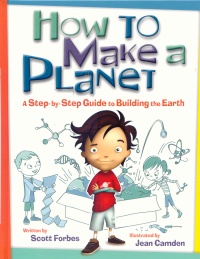| ________________
CM . . .
. Volume XXI Number 5. . . .October 3, 2014
excerpt:
Don’t let the title of Scott Forbes’ How to Make a Planet: A Step by-Step Guide to Building the Earth deter you from adding this book to your library collection or from reading it with your children. It is not a set of instructions for fabricating a papier mâché or plasticine planet. As the excerpts above suggest, it is about the formation of Earth, beginning with the Big Bang, the formation of the universe, and what had to occur for life, including human life, to come to inhabit Earth. This is achieved by using timelines, one that tracks events from the Big Bang at time zero and another that uses today as its reference point and begins 13.7 billion years ago, a date contemporary scientists believe the Big Bang occurred. Not surprisingly, such a story requires some knowledge of elementary physics, chemistry, astronomy, geology, and biology, but Forbes is very good at explaining these ideas for his audience. As interesting as this may sound, Forbes’ goal for writing How to Make a Planet and the manner in which he achieves this aim is what many will consider exceptional. He is telling readers about this billions of years of history because it shows how unique Earth is. He writes: Given all that time, effort and good fortune, you’ll want to take care of your planet. After all, it’s truly amazing that it, and we, exist. Imagine: if it weren’t for its perfect location, magnetic field, water laden comets, the greenhouse effect, the ozone layer – all these things and more – the world you have now might never have taken shape. (p. 58.) The 64 pages of How to Make a Planet are cleverly illustrated with Jean Camden’s cartoon-like and three-dimensional digital illustrations and stock images from Shutterstock. Designer Mark Thacker chose an interesting font for the section headings and sub-headings and has organized pages to include dialogue balloons and text boxes of various shapes. The book ends with a page of “Amazing Facts”, a three-page glossary of terms, and a one-page index. It is not often that one finds a nonfiction science book that is as interesting and informative for adults as it is for youth. Similar to the 2014 television documentary Cosmos: A Space-time Odyssey narrated by Neil deGrasse Tyson, Forbes fits the entire history of the universe into one calendar year. The Big Bang occurs on January 1st, the solar system forms in late August, dinosaurs appear on December 21st and are extinct on December 30th, ape-like creatures show up on the morning of December 31st and start walking upright at 9:00 PM. Homo sapiens, humans, “appear at about five minutes to midnight. But it will only be in the last 39 seconds of the last minute of the last hour of the last day of the year that they will get started on everything we can call history.” Who won’t be amazed by this presentation? Hopefully readers of How to Make a Planet will decide to live in ways that enable Earth and all of Earth’s inhabitants to flourish. Highly Recommended. Barbara McMillan is a teacher educator and a professor of science education in the Faculty of Education, the University of Manitoba.
To comment
on this title or this review, send mail to cm@umanitoba.ca.
Copyright © the Manitoba Library Association. Reproduction for personal
use is permitted only if this copyright notice is maintained. Any
other reproduction is prohibited without permission.
CM Home | Next Review | (Table of Contents for This Issue - October 3, 2014.) | Back Issues | Search | CM Archive | Profiles Archive |
